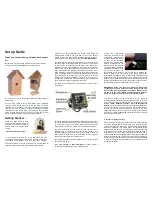Camera Operation & Features
39
PixeLINK PL-A780
Document No.: 04646-01
MACHINE VISION CAMERA
SYSTEM GUIDE
Copyright © 2004 PixeLINK
All Rights Reserved
5.1.4.6 Pixel Addressing
The Pixel Addressing feature controls the number of pixels that
are read from the ROI. See Section 3.2.1 on page 7 for more
information.
Pixel Addressing is controlled by two parameters – a Pixel
Addressing mode and a value. The mode of Pixel Addressing can
be decimate (0), averaging (1), binning (2) or resampling (3). The
Pixel Addressing value can be one of 1, 2, 3, 4 or 6.
With a Pixel Addressing value of 1, the Pixel Addressing mode has no effect and all pixels in
the ROI will be returned. For Pixel Addressing values greater than 1, the number of pixels
will be reduced by the square of the value. For example, a Pixel Addressing value of 2 will
result in ¼ of the pixels.
The Pixel Addressing mode determines how the number of pixels is reduced. The Pixel
Addressing value can be considered as the size of a block of pixels made up of 2x2 groups.
For example, a Pixel Addressing value of 3 will reduce a 6 x 6 block of pixels to a 2 x 2 block
– a reduction of 4/36 or 1/9.
The decimate mode will drop pixels all the pixels in the block except for the top-left group of
four. This creates the 2x2 blocks of pixels shown in Figure 2 to Figure 5 on page 8. At the
highest Pixel Addressing value of 6, a 12 x 12 block of pixels is reduced to 2 x 2. At this level
of reduction detail in the scene can be lost and color artifacts introduced.
The averaging mode will average pixels with the similar color within the block resulting in a
2x2 Bayer pattern. This allows details in the blocks to be detected and reduces the effects of
the color artifacts.
The binning mode will sum pixels with similar color within the block reducing the block to a
2x2 Bayer pattern. Unlike binning with CCD sensors, this summation occurs after the image
is digitized so no increase in sensitivity will be noticed but a dark image will appear brighter.
The resampling mode uses a different approach involving the conversion of the Bayer pattern
in the blocks to RGB pixels. With a Pixel Addressing value of 1, resampling has no effect.
With a Pixel Addressing mode of 2 or more, resampling will convert the block of 10-bit pixels
to one 30-bit RGB pixel by averaging the red, green and blue channels. The 30-bit RGB
value is output from the camera when the video format is set to Y:U:V mode. Resampling will
create images with the highest quality and the least artifacts.
Pixel Addressing will reduce the amount of data coming from the camera. However, only the
Decimate mode will permit an increase in the frame rate. Averaging, binning and resampling
modes will have the same frame rate as if the Pixel Addressing value was 1 (no decimation.)
Pixel Addressing works in the same fashion with color or monochrome sensors.
Parameter Unit Type
Min
Max
Default
Step
Size
Comments
Mode None
Absolute
0
3
0 1
0: Decimate, 1: Average, 2:
Bin, 3: Resample
Value None
Absolute
1
6
1 1
Pixel Addressing Value of 5
is not supported.
Auto No
Manual Yes
One-time
Auto
No
Off Yes
CiD No


















